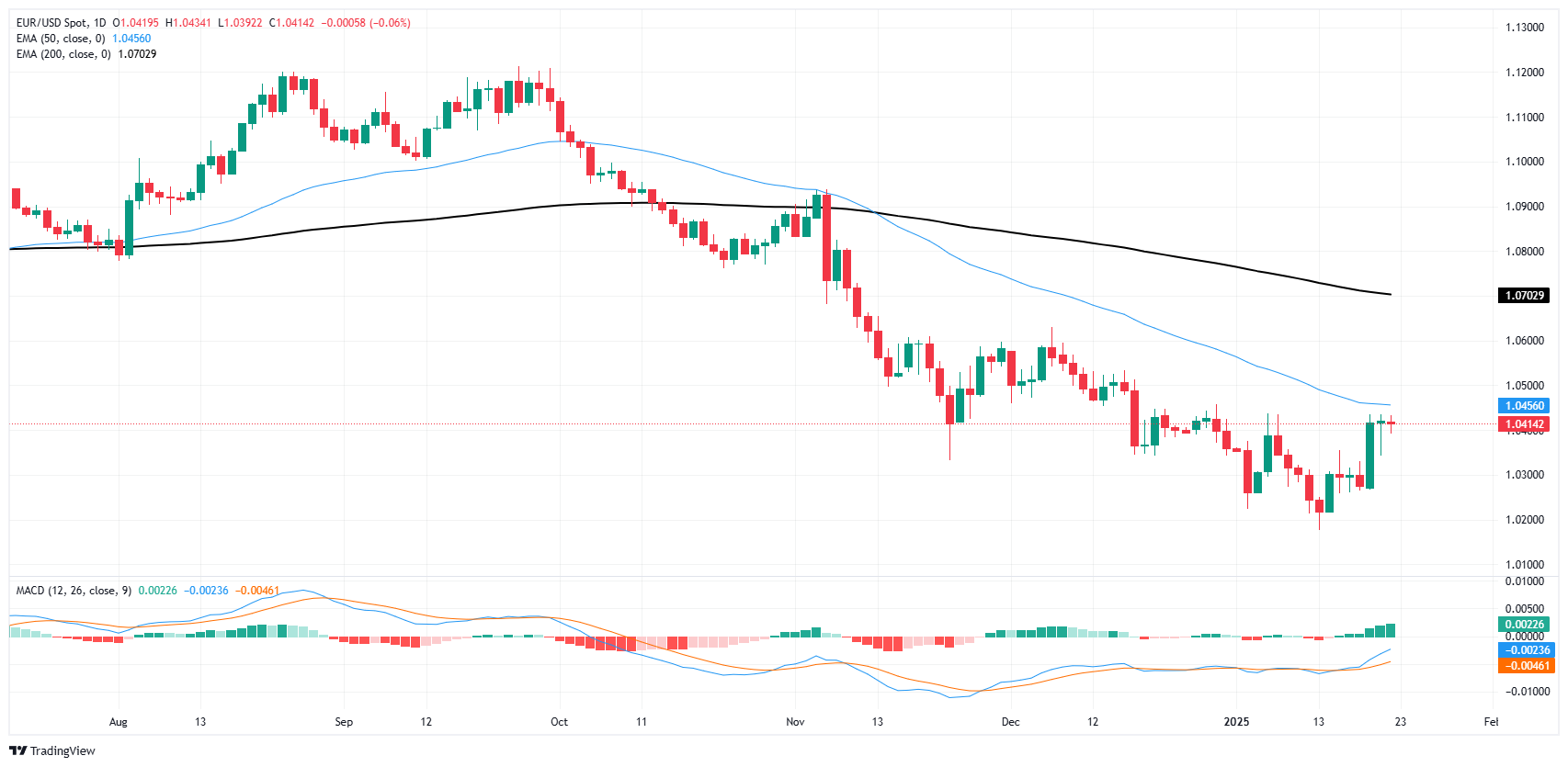EUR/USD muddles along as trade headlines dominate
- EUR/USD cycled around the ever-familiar 1.0400 level on Tuesday.
- European data remains thin this week until Friday’s PMI prints.
- Trade headlines as President Trump waffles on tariff threats will dominate market attention.
EUR/USD ground into a circle on Tuesday, marking in chart churn around the 1.0400 handle as Fiber bids struggle to find direction. European and US economic data remains thin throughout this week, with investor sentiment hinging entirely on whatever trade war rhetoric new US President Donald Trump tweets from one moment to the next.
Over the course of the current trading week, Donald Trump has waffled on his campaign promises of flat tariffs on all of the US’ trading partners on the day he took office. He brushed off his own statements to pivot to threatening new looming tariffs on Mexico, Canada, and China, ranging from 10% to 25%, to start possibly as soon as February 1, over a 48 hour period. President Trump’s ire over perceived trade slights has seen Europe drop from his revenge tariff list, leaving the Euro to get swamped out near familiar technical levels.
The Euro’s expanding interest rate differential against the Greenback has left Fiber in a technically weak position, and a steady slew of mixed messages from a parade of European Central Bank (ECB) speakers is numbing investor interest in further talking points from policymakers. ECB President Christine Lagarde is due to make yet another public appearance on Wednesday, but little of note is likely to come from the exchange.
Looking ahead, Friday will bring a fresh update of Purchasing Managers Index (PMI) business survey results from both the EU and the US. Both datasets are expected to give a mixed print.
EUR/USD price forecast
EUR/USD price action is getting squeezed into a breakout trap in the near term, with an immediate technical floor priced in near 1.0350 and topside momentum getting strangled by the 50-day Exponential Moving Average (EMA) near 1.0450.
Fiber is still trading on the wrong side of the 200-day EMA near 1.0700, but the pair’s slow grind lower appears to be staging something approaching, but not quite reaching, a technical recovery.
EUR/USD daily chart
Euro FAQs
The Euro is the currency for the 19 European Union countries that belong to the Eurozone. It is the second most heavily traded currency in the world behind the US Dollar. In 2022, it accounted for 31% of all foreign exchange transactions, with an average daily turnover of over $2.2 trillion a day. EUR/USD is the most heavily traded currency pair in the world, accounting for an estimated 30% off all transactions, followed by EUR/JPY (4%), EUR/GBP (3%) and EUR/AUD (2%).
The European Central Bank (ECB) in Frankfurt, Germany, is the reserve bank for the Eurozone. The ECB sets interest rates and manages monetary policy. The ECB’s primary mandate is to maintain price stability, which means either controlling inflation or stimulating growth. Its primary tool is the raising or lowering of interest rates. Relatively high interest rates – or the expectation of higher rates – will usually benefit the Euro and vice versa. The ECB Governing Council makes monetary policy decisions at meetings held eight times a year. Decisions are made by heads of the Eurozone national banks and six permanent members, including the President of the ECB, Christine Lagarde.
Eurozone inflation data, measured by the Harmonized Index of Consumer Prices (HICP), is an important econometric for the Euro. If inflation rises more than expected, especially if above the ECB’s 2% target, it obliges the ECB to raise interest rates to bring it back under control. Relatively high interest rates compared to its counterparts will usually benefit the Euro, as it makes the region more attractive as a place for global investors to park their money.
Data releases gauge the health of the economy and can impact on the Euro. Indicators such as GDP, Manufacturing and Services PMIs, employment, and consumer sentiment surveys can all influence the direction of the single currency. A strong economy is good for the Euro. Not only does it attract more foreign investment but it may encourage the ECB to put up interest rates, which will directly strengthen the Euro. Otherwise, if economic data is weak, the Euro is likely to fall. Economic data for the four largest economies in the euro area (Germany, France, Italy and Spain) are especially significant, as they account for 75% of the Eurozone’s economy.
Another significant data release for the Euro is the Trade Balance. This indicator measures the difference between what a country earns from its exports and what it spends on imports over a given period. If a country produces highly sought after exports then its currency will gain in value purely from the extra demand created from foreign buyers seeking to purchase these goods. Therefore, a positive net Trade Balance strengthens a currency and vice versa for a negative balance.


